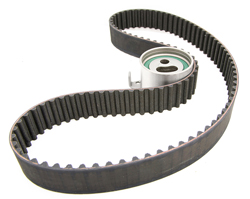
The belt itself is flat on the outside and has teeth on the inside which connect the cam shaft and the engine’s valves. Generally made of a rubber composite and frequently combined with more heavy duty fibers, the belt connects the crankshaft to the camshaft and synchronizes the timing of the two. The camshaft is responsible for opening and closing the valves of the engine.
Your timing belt will most likely not be visible to you when you open your vehicle’s hood as they are generally located behind the serpentine belt and underneath a protective metal cover. This cover serves to protect your engine by keeping out dirt and other foreign objects. Unfortunately, the location makes it difficult to access the belt. This inconvenience is why the labor charge on timing belt maintenance and repair is so costly.
Under the protective cover, in addition to the timing belt, there is also often an automatic tensioner, a water pump driven by the belt, and one or more idler pulleys that helps direct the path of the belt. The cost of these parts is very small compared to the associated labor costs so it is highly advisable to replace all of this hardware at the same time you replace your timing belt. Not replacing these parts will significantly reduce the life expectancy of your replacement belt.
Failing to properly maintain the timing belt can result in the belt breaking. Without the belt synchronizing the timing of the camshaft and the valves bad things can happen. Pistons hit valves which can result in those valves and pistons being bent or broken, as well as the camshaft being damaged. These are all very expensive repairs that you want to avoid.
You should consult your owners manual and follow your manufacturer’s recommendations for timing belt replacement. This interval can vary greatly from vehicle to vehicle so what applies to one car does not necessarily apply to the next.
It is possible to do your own work and replace your own timing belt and related hardware but it is not a project that is recommended for a beginner. As mentioned before, due to the belt’s location behind the serpentine belt assembly, accessing it is difficult. Doing the work yourself can save you a considerable amount of money since the largest share of the repair costs are labor. If you are going to undertake this project yourself, make sure you consult a repair guide and fully document the process so you can return all the parts to where they belong.
Your timing belt is a critical component of your engine and you shouldn’t wait for it to wear out or break. Make sure you follow your manufacturer’s recommendation regarding belt replacement intervals. This will help you avoid those inconvenient breakdowns and costly engine repairs.